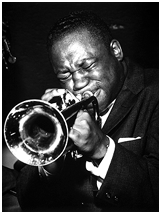![]()
![]()
![]()
![]()
![]()
![]()
Woody Shaw, trumpeter
Like Clifford, Woody Shaw was an innovative trumpeter who died young. In the late seventies, Shaw recorded a version of “What is This Thing Called Love?” based on the Clifford Brown/Max Roach recording of 1954. Reviewer Zan Stewart said of the recording in 2002 that Shaw “reveal[s] his profound affection for Brown [and] unleashes streams of tuneful, bebop-meets-modern thought.”[1]
Freddie Hubbard, trumpeter
In 2001, the innovative trumpeter Freddie Hubbard said:
“My main influence was Clifford Brown; I carried the records he made with Max anywhere.”[2]
Lee Morgan, trumpeter
“Morgan frequented the Browns' household in west Philadelphia between 1954 and 1956, receiving invaluable instruction from Brown, though he did not take formal lessons with him.”[3]
Booker Little, trumpeter
Trumpeter Booker Little sured a few similarities with Clifford. He followed in Brown's footsteps when he became the trumpeter in Max Roach's group in 1958 and was also an innovative musician who died at a very early age (only 23). He had a great love of Brown's sound and copied the style.
“Like Morgan and Hubbard, Little was deeply indebted to Clifford Brown, and he consciously struggled to escape from Brown's powerful influence and develop an individual sound.”[4]
Terence Blanchard, trumpeter
“One of the first [favorite records] was ''Clifford Brown-Max Roach, Inc.'' with Clifford playing Sweet Clifford--it just blew my mind!”
Roy Hargrove, trumpeter
“The thing that impressed me most was Clifford Brown's sound and his dexterity. But mostly his sound. He stretched it past the boundaries so that the trumpet sounded more like a wood-wind instrument. He had tremendous facility in the way he played ballads. I've got to get some Clifford listening in at least once a day.”[5]
Wynton Marsalis, trumpeter
Wynton lists At Basin Street as one of the first jazz records he listened to.[6]
Jean-Luc Ponty, fusion violinist
“My influences were horn players, starting with Clifford Brown...”[7]
[1]Zan Stewart, “Reviews: Woody Shaw: “Live Volume Two,” Downbeat, April 2002, 62.
[2]Ted Panken, “Making It Me: Freddie Hubbard Maps Out His Musical Road to Greatness,” Downbeat, October 2001, 36.
[3]Jeffery S McMillan, “A Musical Education: Lee Morgan and the Philadelphia Jazz Scene in the 1950s,” Current Musicology, Spring 2001-Spring 2002, 168.
[4]David Diamond and Keith Waters, “Out Front: The Art of Booker Little,” Annual Review of Jazz Studies, 2000-2001, 1.
[5]Dan Ouellette, “Blindfold Test,” Downbeat, November 2003, 90.
[6]Royal S. Brown, “An Interview with Wynton Marsalis,” Fanfare – The Magazine for Serious Record Collectors, July-August 1996, 12.
[7]Dave McElfresh, “Jazz Sides: 10 Questions for ... Jean-Luc Ponty,” Goldmine, 7 September 2001, 22.
